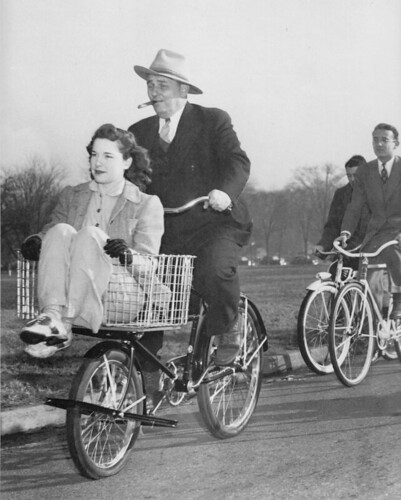Right now in Chicago, advocates are calling for a coherent network of separated bikeways that will make it safe and convenient to get around the city on two wheels. More than a century ago, Windy City cyclists were doing exactly the same thing, according to James Longhurst, author of the new book “Bike Battles: A History of Sharing the American Road.”
Longhurst, who teaches public policy history at the University of Wisconsin-La Crosse, will be discussing “Bike Battles” this Thursday at 6 p.m. at the Seminary Co-op bookstore, 5751 South Woodlawn in Hyde Park. The event is co-hosted by the Active Transportation Alliance and the Blackstone Bicycle Works.
"Bike Battles" examines various debates over bicycles and their place in history since the 1870s. “One of my favorite stories is the sidepath movement of the 1890s,” Longhurst said. “Nobody knows a damn thing about it nowadays.” During the height of the turn-of-the-century bicycle boom, cyclists throughout the Northeast and Midwest were pushing to create separated bikeway networks within cities, as well as a system of sidepaths connecting cities across North America. Chicago would have been a major hub of this bicycle interstate system.
“Chicago had big plans in the 1890s to build bike-specific infrastructure, most of which didn’t happen,” Longhurst said. Some local cyclists called for reserving certain downtown streets and bridges, such as Washington and Dearborn, for bicycles traffic during the morning rush hour. They also proposed a bike tax to help fund infrastructure. “So we actually have already had this discussion of how to build a separated network of bikeways and pay for it.”
Unfortunately, the sidepath movement fizzled out after less than ten years. Just like today, there was political opposition to using tax revenue for bike-only facilities. “It was too easy to declare that dedicated bike infrastructure was not in the public good,” Longhurst said.
Eventually, most bike advocates got behind the Good Roads movement, which called for using taxes to fund professionally engineered roads, as opposed to the rough dirt tracks that were common at the time. The cyclists were allied with farmers, who wanted to be able to transport their goods to market faster via horse-drawn carts. “In the early 1900s, it seemed like we would get a network of high-quality roads that would be shared by wagons, trollies, omnibuses, and bicycles,” Longhurst said.
We all know what happened next. Paved roads enabled the automobile industry, and the speed and volume of car traffic snowballed. While it was previously normal for people to walk in the street, the auto industry invented the concept of jaywalking in the 1920s, with ad campaigns urging pedestrians to stay out of the roads. “Bicycling had already fallen out of its faddish popularity of the 1890, and it never really recovered.” Longhurst said. “What had been a shared-use road system became mono-modal.”
Longhurst sees the sidepath movement as a public policy road not taken, which is the dominant theme in his book. “Although my publisher thought the title ‘Bike Battles’ would help sell copies, I’m really not interested in promoting the rhetoric of bikes versus cars,” he said. “I wanted to look at a bunch of somewhat forgotten moments in history when we chose one mode over another. These were decisions that brought us to the model of the autocentric city that we’re now trying to reverse engineer our way out of.”
Each chapter covers a different era in U.S. bike history. In addition to the 1890s sidepath movement, Longhurst discusses the 1870s legal battle to decide whether bicycles would be considered vehicles. He looks at the auto industry’s success with getting cars-first vehicle codes passed in the 1930s. During World War II, the federal government’s decision to force American bike companies to produce low-quality, unpopular “Victory Bikes” in order to conserve steel unintentionally crippled the domestic bike industry.
Postwar, the U.S. and Japanese governments agreed to promote bike manufacturing in Japan as a peaceful industry to help rebuild that nation’s economy. Decades later, that led to an influx of affordable Japanese ten-speeds to the U.S. market, which helped fuel the 1970s bicycle revival, although American advocates had only limited success getting bike infrastructure built.
Longhurst, who has been spending this week doing research at the University of Chicago, said his book project was aided by the fact that Chicago newspapers kept writing about cycling long after their counterparts in other cities lost interest. "I really benefitted from the Chicago Daily Tribune [now the Chicago Tribune] archives,” he said. “And during the 1960s and ‘70s, Chicago continued to have active bicycle advocacy at a time when it didn’t really appear anywhere else. That was, of course, because Schwinn was headquartered here.”
“It’s not really by intent that we now have streets filled with cars,” Longhurst concluded. “It’s really the product of a series of decisions and over a century or more. I believe that emphasizing the importance of choice and happenstance frees us, because it doesn’t mean that the transportation system we have now is the best of all possible options – it’s merely the place we’ve ended up. That means we can we can make new choices and change what we have.”







